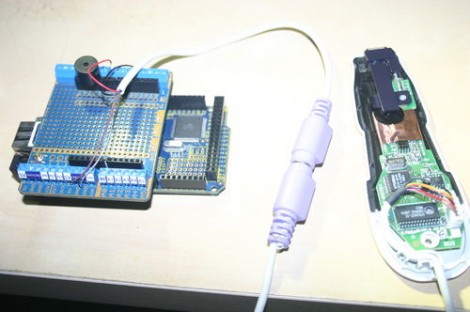
[Damcave] decided to try out some bar code reader projects. He got his hands on a CueCat years ago. The problem is that it outputs encrypted character sets instead of a clear text string. To get around this he used his Arduino to decrypt the CueCat’s data output.
Originally you could get you hands on a CueCat for free. It was meant to work like QR codes do now — you see a bar code, you scan it to get to a web address. It never really took off but you can still get your hands on one for about twelve clams. We’ve seen projects that clip a pin on the processor to disable to encryption. But [Damcave] didn’t want to mess with the hardware. Instead he connected the Arduino via the PS/2 connector and used software to translate the data. The encryption format has long been know so it was just a matter of translating the steps into an Arduino function.















wow, i just found one of those cleaning up and was about to do the same thing. But there is an easier way to read the data, there is a pin on one of the chips (i think it was pin 11), that you can cut that forces it to output raw number strings. I have a modified one somewhere, Ill have to pull it out to find out what pin it was.
The “encryption” is so basic that I don’t know if it’s really worth it to bypass it!
On winXP there was a a little app (catnip ?) that could decode for you. Used it a lot cataloging my DVD collection. I’m not sure if it would work on win7 and it would probably be easier for me to cut a pin on a chip than write a app to decode it.
cat nip does work on windows 7. http://www.cedmagic.com/cuecat/cuecat.html
Other than being an intellectual exercise, this is like going from Los Angeles to Burbank by way of Las Vegas. Why bother when clipping that one little pin will get the same result?
Sometimes, it’s not the destination but the adventures during the journey.
While visiting the town where my grandparents live, (I lived with them while going to college) the local Radio Shack/thrift shop/hardware store (which I frequented regularly while in college) had a ton of these (5 boxes) that they just gave to me after 3 months of nobody showing interest. The town finally got broadband service in ’03. Before that, it was dial-up service to a long-distance number unless you were a college student willing to use CompuServe on an ISDN line.
Unfortunately, I didn’t have enough room in my car to pack all my belongings and the trailer that was my electronics shop caught fire from a lightning strike. Oh, how I wish I hadn’t taken my broken TV instead of the CueCats!
The Inventor of the CueCat is still around. His website: http://www.jhuttonpulitzer.com/ touts it as an amazing success. Some of us remember differently, but the website is worth (and kind of) a “trip”…
from that page ” CueCats are HUGE sellers on eBay! ”
Well yeah..its a barcode scanner. Surely they dont think we use them for their intended purpose?
I got a USB Cue Cat. There were several variants, some needed a little more surgery to declaw. Fortunately the one I have was a simple single pin clip to disable both its serial number and the pitiful encryption.
After the modification a Cue Cat becomes a normal PS/2 “wedge” or a USB “keyboard” device. It’ll scan barcodes and drop the numbers anywhere the text cursor is, no special drivers required.
yeah, i used to open notepad and go around scanning unlabeled bar-codes. you’d be surprised how many are 000000.